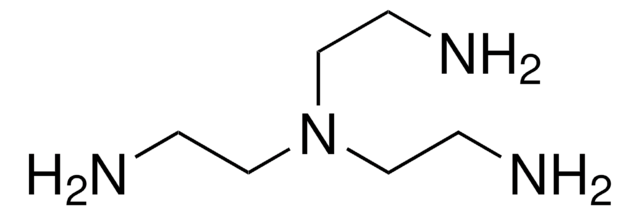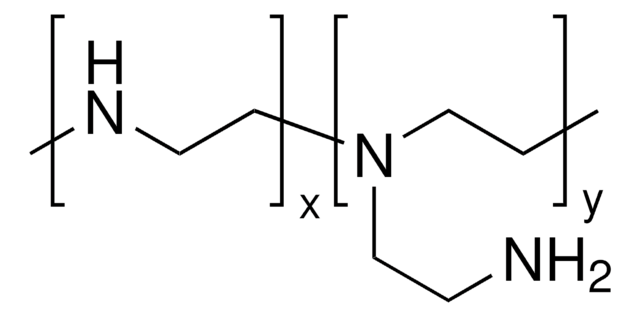408719
Polyethylenimine, ethylenediamine end-capped
average Mw ~800 by LS, average Mn ~600 by GPC
Sinónimos:
PEI, ethylenediamine branched
About This Item
Productos recomendados
formulario
viscous liquid
Nivel de calidad
mol peso
average Mn ~600 by GPC
average Mw ~800 by LS
índice de refracción
n20/D 1.5240
densidad
1.050 g/mL at 25 °C
InChI
1S/C2H8N2.C2H5N/c3-1-2-4;1-2-3-1/h1-4H2;3H,1-2H2
Clave InChI
SFLOAOINZSFFAE-UHFFFAOYSA-N
Categorías relacionadas
Descripción general
Aplicación
Bamboo charcoal impregnated with PEI can be used as a CO2 adsorbent. Numerous amino groups present in PEI can react with CO2 due to acid-alkali interaction and enhance the adsorption capacity of bamboo charcoal.
It can also be used to prepare cross-linked water-soluble polymers with high coordination capabilities towards organic drug molecules.
Características y beneficios
- Branched PEI has better complexation and buffering capacity.
- High ion exchange capacity and affinity toward proteins.
- SignificantDNA transfer efficiency.
Forma física
Palabra de señalización
Danger
Frases de peligro
Consejos de prudencia
Clasificaciones de peligro
Acute Tox. 4 Oral - Aquatic Chronic 2 - Eye Dam. 1
Código de clase de almacenamiento
10 - Combustible liquids
Clase de riesgo para el agua (WGK)
WGK 3
Punto de inflamabilidad (°F)
356.0 °F
Punto de inflamabilidad (°C)
180 °C
Equipo de protección personal
Eyeshields, Faceshields, Gloves, type ABEK (EN14387) respirator filter
Elija entre una de las versiones más recientes:
¿Ya tiene este producto?
Encuentre la documentación para los productos que ha comprado recientemente en la Biblioteca de documentos.
Los clientes también vieron
Artículos
Professor Yoshiki Katayama (Kyushu University, Japan) discusses recent advances in drug delivery systems and strategies that exploit the EPR effect, with a special focus on stimuli-responsive systems based on novel materials.
We present an article that discusses two applications in particular; first, using these layers as polyelectrolyte membranes to control permeability.
Nuestro equipo de científicos tiene experiencia en todas las áreas de investigación: Ciencias de la vida, Ciencia de los materiales, Síntesis química, Cromatografía, Analítica y muchas otras.
Póngase en contacto con el Servicio técnico










